Park Güell offers a surreal outdoor experience in a city full of architectural wonders. It’s Antoni Gaudí at his most imaginative and creative.
Originally intended as a residential area and playground for the wealthy, the project never fully materialized.
Gaudi built the infrastructure. But after 14 years, the plan was abandoned when the rich never moved in.
Today, Park Güell is a 30 acre public park featuring stunning pavilions, whimsical gingerbread houses, and a serpentine bench with spectacular views over the city.
In this guide to Park Güell, I’ll cover everything you need to see and provide essential tips for visiting.

Quick Tips
- Be forewarned, Park Güell is incredibly popular!
- The only smart way to visit is to reserve your ticket online well in advance, as there is a cap on the number of visitors.
- You can get there via metro, bus, taxi, or the hop on hop off bus. Taxi is the easiest if you want to avoid an uphill climb to the entrance.
- Book a guided tour if tickets are sold out or you want a little history and easy transportation to the park.
Mini History of Park Güell
Though Park Güell is one of the most singular parks in the world, its beginning were more prosaic.
Eusbie Güell envisioned the space as an English-style garden city. It was intended to host 60 upscale homes for the Barcelona aristocracy.

The community was intended as a haven for “healthy living” away from the city’s plagues.
Both Güell and Gaudi were focused on physical and spiritual health.
Work began in 1900. But Güell miscalculated.
Turns out, the wealthy didn’t want to move to the suburbs where there was no metro station or anything cultural to do.
After 14 years, Güell gave up on the project. At that time, Gaudi had already completed the walls, gatehouses, grottos, plaza, fountains, and pavilions.
Throughout the park, columns and porticos echo Greek architectural styles and symbolism. Gaudi admired classical forms and reinterpreted them in his usual eccentric, organic manner.
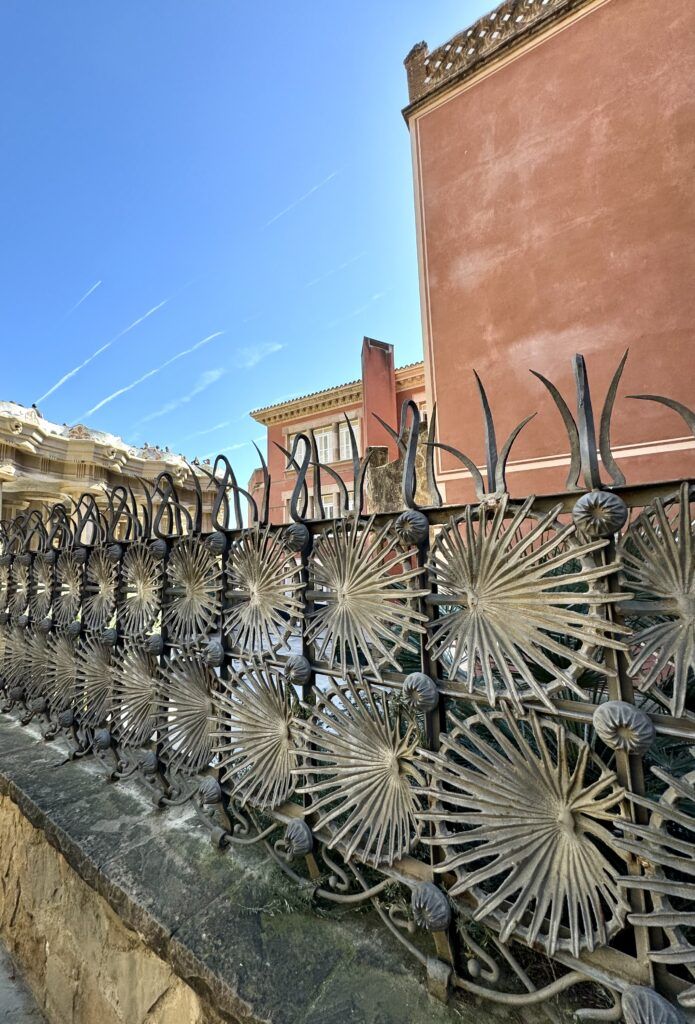
In 1922, the city purchased the property to use as a public park. In 1984, it was accorded UNESCO World Heritage status.
Guide To Park Güell: What To See
Main Gate
Park Güell was designed as a walled precinct, emphasizing its isolation from the rest of the city.
The main gate is wrought iron and was brought from Gaudi’s first house, Casa Vicens. The design uses fan palm leaves as a template.

Gatehouses
The main entrance has a Hansel and Gretel gatehouse on each side, each with its own distinctive character.
The gatehouse on the left was originally intended to be the park’s administration building. It has an undulating roof and distinctive blue and white checkered tower.
The roof is made of trencadis — broken ceramic bits rearranged into new patterns. The top of the tower looks a bit like a champagne plug.
Today, the gatehouse houses an excellent souvenir and book shop.
The gatehouse on the right is the porter’s lodge, also know as the Guard House.

It’s a humble dwelling that Gaudi designed with the same love and creativity he used on grander buildings. It also has a trencadis roof and trencadis medallions framing the windows.
The lodge houses an exhibition called Güell, Gaudi, and Barcelona.
You’ll have to wait in line to enter. I thought it was fairly skippable, though the views from the top floor are very nice.
Carriage Shelter
At the foot of the staircase, on the right hand side, Gaudi built a rough hewn cave with three parabolic arches at the entrance.
It has a circular floor plan and a cone-shaped central column that looks like a chalice or goblet.
The cave was used as a shelter for carriages and was designed to allow them to enter and leave easily.

Staircase
The twin staircase is monumental. It consists of four flights of steps and takes you from the entrance up to the Hypostyle Hall and the terrace.
The side walls have cushion-effect geometric decorations and are topped with trencadis-decorated crenellations.
The first three flights of stairs have raised pools in the center with cascading water. The basin motifs are the grotto, the snake, and the dragon.
The first pool is a grotto made of trees, roots, and stalactites. It was intended to be a symbol of safety and protection.
The second pool features the head of a snake set in a medallion and emerging from a Catalan flag. The snake, possibly based on Mose’s bronze serpent in the Bible, symbolizes medicine and health.

The third basin is home to the park’s most beloved creature, the smiling dragon or salamander known as El Drac. It’s the most photographed spot in the park.
He’s designed in Gaudi’s signature trencadis style. The dragon’s bright colors and intricate patterns make it a striking piece of art.
Like so many elements of the park, the dragon has been the subject of countless interpretations.
It’s variously thought to be the mythical guardian of the park, a dragon from Catalan folklore, or possibly Apollo’s dragon from the Temple of Delphi.
At the top of the stairs is a bench where you can rest and admire the views. The bench resembles a gaping mouth, bordered in green and orange trencadis.


Hypostyle Hall
The staircase leads up to the Hypostyle Hall, which is also known as the colonnade or the Doric Temple. It was my favorite space in the park.
The hall was intended as the site of a fortnightly market selling provisions to the Park Guell residents.
It was based on a Greek design with fluted Doric columns, the only time Gaudi used this theme in his work. Still, he put his own stamp on the hall.
The shafts of the 86 columns are set into a soft capitals. The ceiling is covered white trencadis tiles.
Gaudi added colorful ceiling soffits, which are medallions in the shape of a sun with 20 rays. The ribbon interwoven in the center of the sun represents Hermes, the good of industry and commerce.


There are 14 other roundels set into the white trencadis roof, which serve as moons to the suns.
Plaza
The grand plaza, known as Nature Square, is a highlight of your visit. It was intended as the social hub of the community and has stunning views over the city.
Gaudi called it the “Greek Theater” is his initial plans.
At the time, open air theater performances were in vogue. But it’s more akin to a Greek agora.
Half of the plaza rests on the columns of the Hypostyle Hall. The other half was dug out of rock.
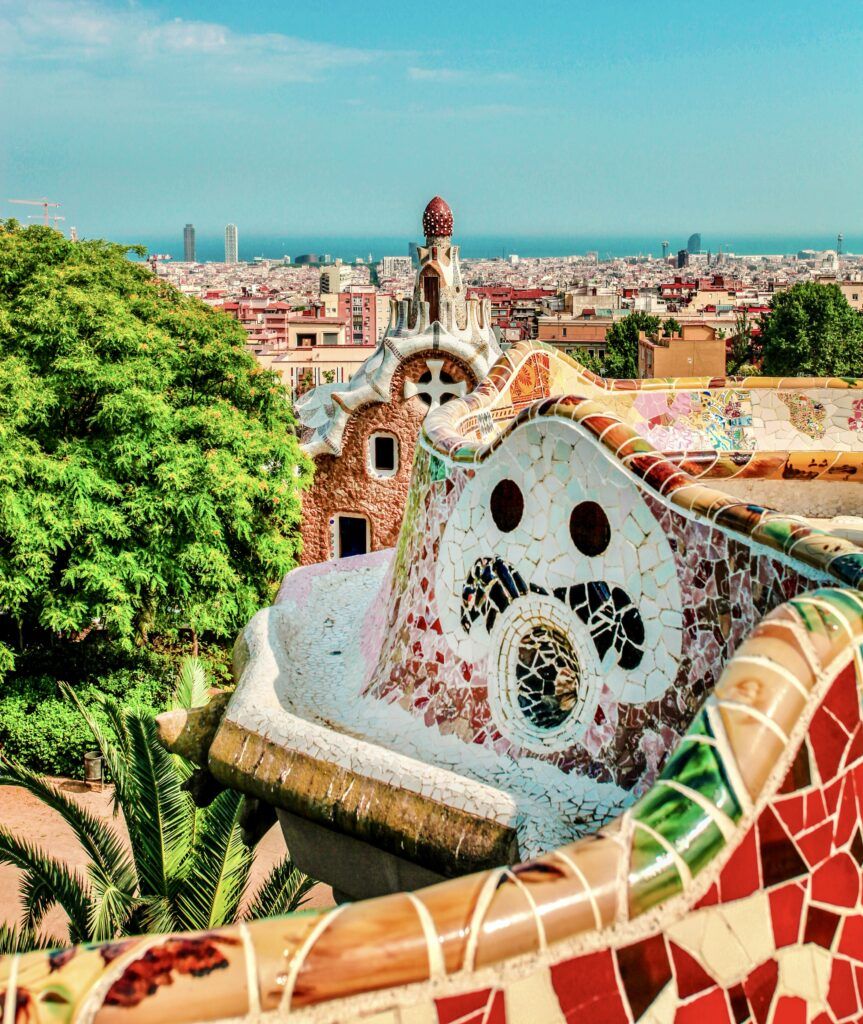
Serpentine Bench
A serpentine bench lines the edge of the plaza. It’s effectively an undulating balcony slathered in trecandis mosaics.
Gaudi designed the bench and its trencadis tile decorations came courtesy of Josep Maria Jujol. The bench is considered one of the great works of Modernism.
It’s set out in an alternative concave and convex pattern, which creates the spiraling effect. There are individual spaces resembling booths, which are the perfect place to sit and chat.
The back of the benches are decorated with medallions in a palm frond motif that morphs into different animals shapes. Between them, you’ll notice signs of the zodiac and celestial bodies in trencadis.
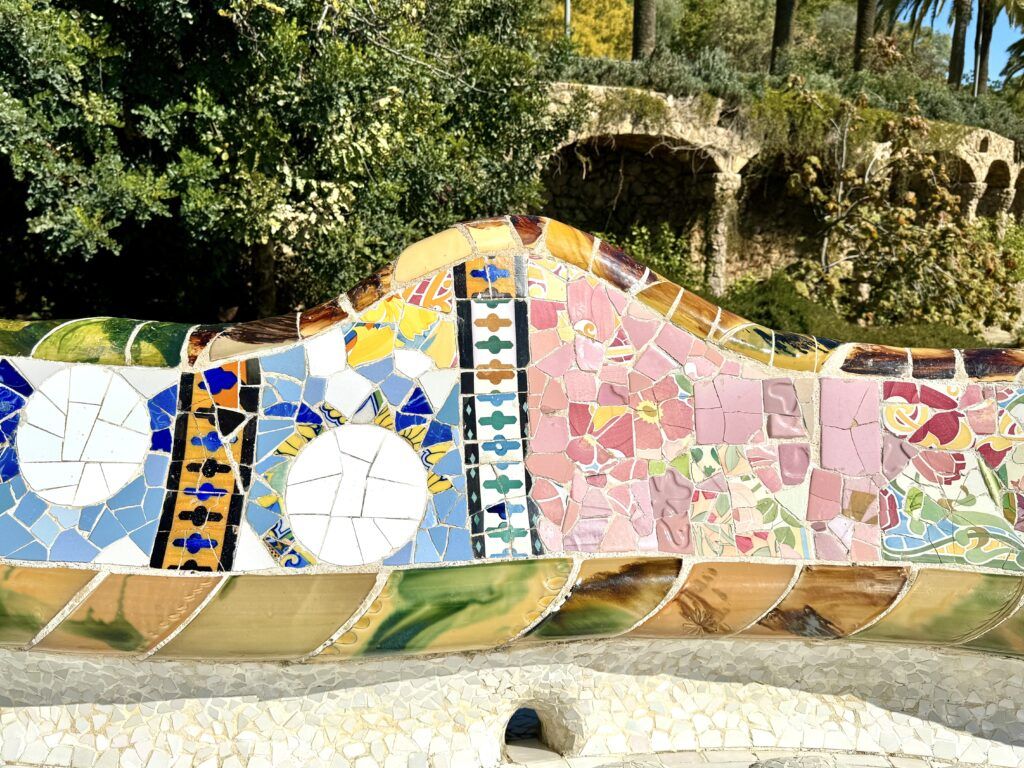

The front of the bench is simply gorgeous. It’s a kaleidoscope of patterns, colors, and shapes. Indeed, one might consider the composition a precursor to abstract art and collage.
If you look closely, you will see Jujol’s inscriptions in Catalan in the half round moldings that cap the bench. They resemble graffiti before it existed as an art form.
Despite its artistic complexity, the bench is designed with comfort in mind.
The wavy shape conforms to the human body, providing ergonomic seating for visitors. Gaudi even tested it out on his workers.
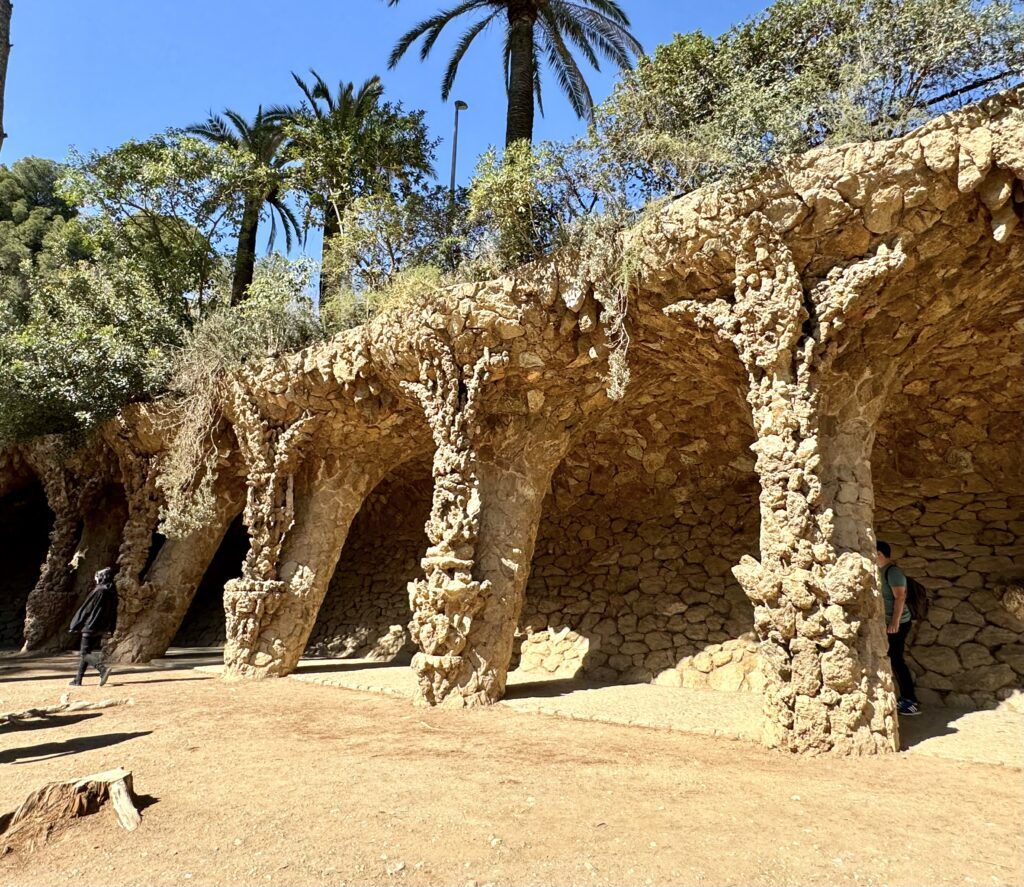
Portico Viaducts
A network of porticoed paths wind their way through the northeast section of the park. The porticos are integrated into the natural setting and provide shelter from sun or rain.
Their grotto-like appearance and organic shapes make them appear as living things. And gives them a contemplative atmosphere, similar to a cloister.
There is a lower, middle, and upper viaduct. Each has a distinctive design.
Unlike the other viaducts, the upper one has benches attached to some of the outer columns.

Laundrywoman Portico
The most interesting portico is the laundrywoman portico to the left of the main entrance.
It’s named after a stone sculpture of a woman, which is the only human figure in the park.
On the top is a spiral ramp with one row of columns that lean inward. Below are vaulted ceilings with slanted walls.
It’s an incredibly popular photo spot!
Casa Güell
Gaudi remodeled this house for the Guell family, who moved here from Palau Güell in the Gothic Quarter.
The little mounds of stone that decorate the top of the chimneys were one of Gaudi’s interventions.

Gaudi Museum
Casa Museu Gaudi is in the free zone.
It was originally the show house for the park. When it didn’t sell, Gaudi moved in and lived there from 1906 to 1925, before moving into Sagrada Familia for good.
The pink colored house, though more traditional, does have Gaudi’s trencadis chimneys in the shape of mushrooms.
Today, it houses the Gaudi Museum. Access is via a separate ticket and you’ll have to queue up to get inside.
The museum displays a wealth of original furniture from Casa Calvet and Casa Batllo, models, drawings, and momentos of the architect. You’ll also see a portrait of Guell and a bust of Gaudi.
You can purchase tickets in advance through the Sagrada Familia website, and even purchase a combination ticket for both places.

Three Crosses of Calvary
The Calvary is the highest point of the park, and a sacred summit. It’s reached by winding pathways, including the Rosary Way.
It was initially conceived as a spot for a chapel. But, when the plots failed to sell, it was never built.
Instead, Gaudi built a stone outcrop that looks almost like a prehistoric structure. It’s topped with three crosses, evoking Christ’s suffering on the cross.
Practical Guide To Visiting Park Güell
Here are some must know tips for visiting Park Güell.
Address:
Carrer d’Olot, s/n, 08024 Barcelona

The park is located beyond the Gracia neighborhood, in Barcelona’s foothills.
The main entrance on Carrer d’Olot provides the best access and leads directly to the most famous parts of the park.
The side entrance of Carrera del Carmel, however, takes you on a nice walk through the park past the viaducts before you get to the Monumental Zone.
How To Get There:
By Bus: Take lines H6, 32, 24, and 9. The bus drops you about four blocks from the entrance.
By Metro: Take L3 to Lesseps or Alfons X. It’s a steep 15 minute hike uphill from the metro stations.
By Hop on Hop off Bus: The tourist bus also drops you about four blocks from the entrance.

Tickets:
Most of the park can be visited for free, including the pathways and trails, viaducts, and the Calvary viewpoint.
However, you will need to pay an entrance fee in order to visit the “Monumental Zone.” This is the area that includes the highlights.
The cost on the official website, which is a bit finicky to use, is 10 €.
Tickets bought here are non-refundable. If you want flexibility and don’t mind paying a bit extra, then it’s a good idea to buy tickets from Get Your Guide.
Admission is also included with the Barcelona City Pass, but you’ll have to make a timed reservation.
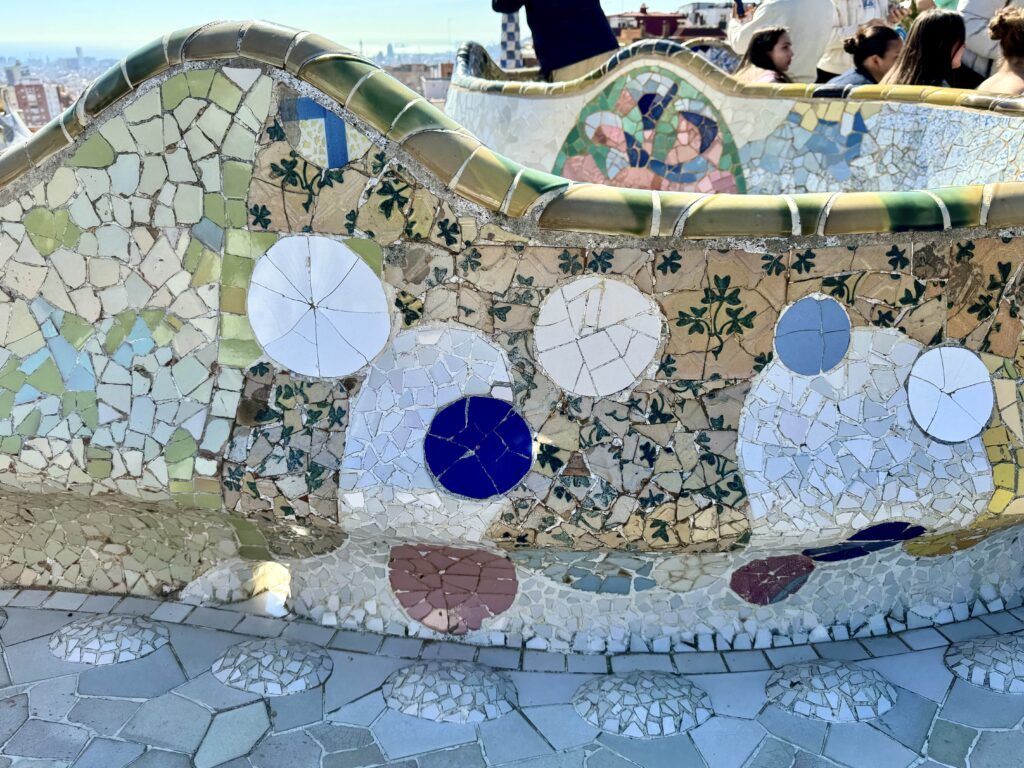
You must enter within 30 minutes of your designated timed entry. If you don’t make it in time, you won’t be allowed to enter.
I suggest arriving 15 minutes early to get situated. Once inside, you can stay in the park as long as you wish.
The Gaudi House Museum is a separate charge of € 5.50 euros.
Purchasing a ticket in advance also includes Bus Guell, a direct ride to Park Guell from the Alfons X metro station. The bus ride takes about 15 minutes.
This saves you a long walk uphill on the way to the park and downhill on the way out of the park.
Hours:
April to October 9:30 am to 7:30 pm. Rest of the year 9:30 am until sunset.

Is Park Güell Worth Visiting?
Park Guell is well worth visiting! It’s quite beautiful and a chance to see inside Gaudi’s creative mind.
The one downside is the massive crowds. To me, this makes Park Guell less attractive to visit than more off the beaten path Gaudi sites like Palau Guell or Casa Vicens.
If you are pinched for time in the city, I wouldn’t say Park Guell is a must do. But if you need some green space away from the city or are on the Gaudi trail, it might just fit the bill.
Pro Tips:
The highlights of the park are mostly squished together. But the park itself is fairly big and not well marked. There are no maps.
For this reason, among others, it’s perhaps advisable to book a guided tour.
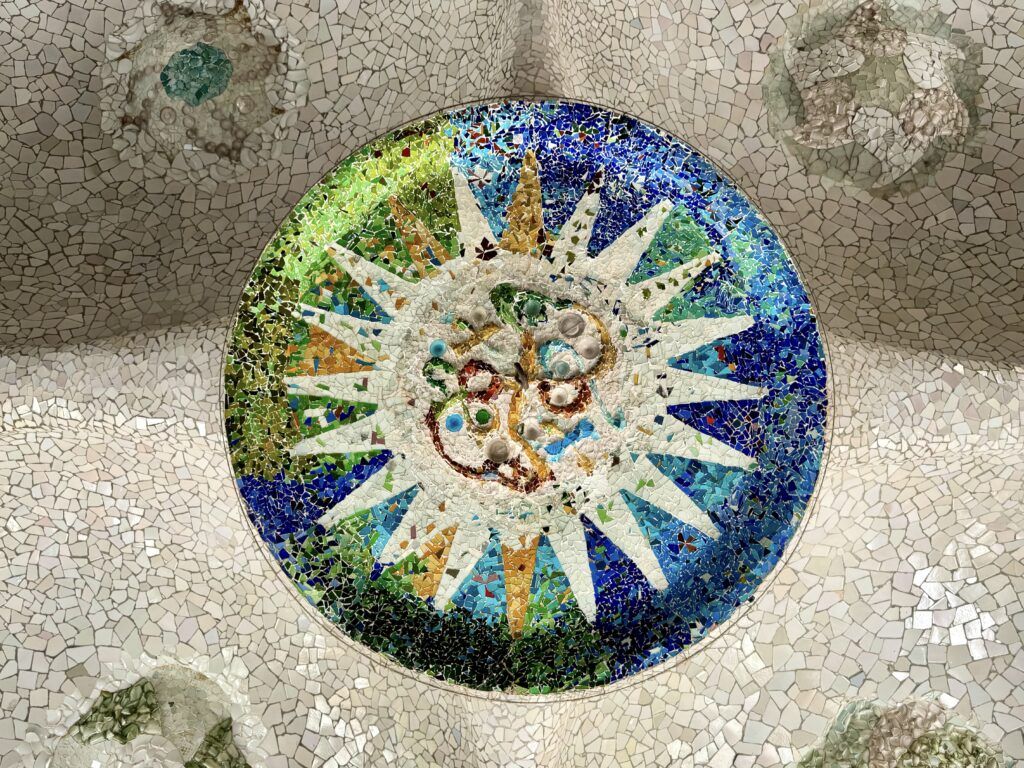
Try to visit as early as possible on a week day and head directly to the things you want to see before the crowds descend.
There are limited options for purchasing food and drinks inside the park, so it’s a good idea to bring your own, especially on hot days.
There are lockers to store backpacks. But not many of them, so bring something small to carry.
I recommend budgeting 2 hours to see everything within the park. Less time if you are only visiting the Monumental Zone. More time if you want to wander.
I hope you’ve enjoyed my guide to Park Güell. You may find these other Barcelona travel guides useful:
- 1 day in Barcelona itinerary
- 2 days in Barcelona itinerary
- 3 days in Barcelona itinerary
- 5 days in Barcelona itinerary
- what to do in the Gothic Quarter
- best museums in Barcelona
- hidden gems in Barcelona
- landmarks in Barcelona
- guide to architecture in Eixample
Pin it for later.


